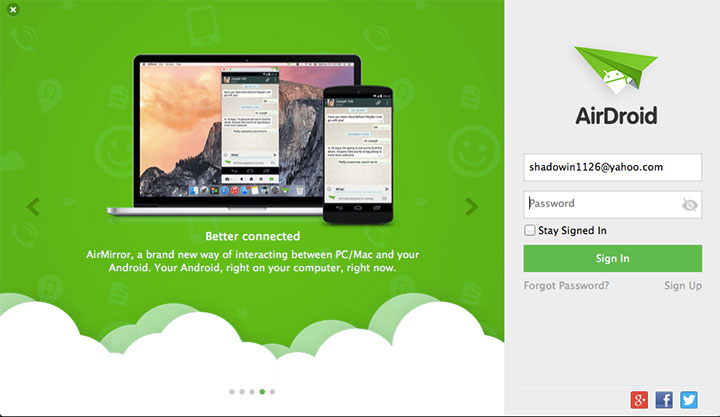
AirDroid
AirDroid app already offers a great solution to control your Android phone from a Mac or Windows PC. Many would debate that screen mirroring isn’t anything new. Apple has a feature called AirPlay built in tvOS, macOS and iOS, whereas Android phones let you mirror the screen from phone to your smart TV using Miracast or screen mirroring. With AirMirror, you get the ability to control one mobile device using other. I tried using an iPhone to control an Android phone and it works pretty well too. And the process is a little complicated, but not that difficult. Here’s how to go about it.
Getting your device ready for AirMirror
Step One
To begin with, download AirMirror desktop client for Windows or macOS from here – airdroid.com/en/get.html.
Step Two
Download the AirMirror and AirDroid apps on your Android from Google Play Store, and on iPhone from Apple App Store.
Step Three
Sign up for an account if you don’t already have one. And if you do, sign in with the ID on all the devices – Android, iPhone and desktop client.

Step Four
On your Android smartphone, head over to Settings > About > Software and tap 7 times on build number to enable Developer Mode. (The menu may be different from one device to other, but you need to enable Developer Mode by clicking on build number under software.)
Next, head to Developer Options on your Android smartphone
See also: 4 Steps on How to record your GamePlay on Android ?
How to use AirMirror
Step One
Once the above steps are complete, connect your Android device
Step Two
On the left panel, you will find a binocular-like icon, click on that, and then click on non-root tab. Connect your phone to PC and give the required permissions, and you’re done.
Now, your phone is configured to be operated remotely using the AirMirror app. Open desktop app, click on AirMirror, and click on the device you want to control. Next, click on AirMirror, and after the connection is established, you will now see the Android screen on your desktop.
Similarly, you can also use an iPhone
For instance, you can make phone calls, but you need to phone to talk to the other person. Secondly, as a security measure, if the screen is locked with a fingerprint or PIN code, you can’t simply access without biometric authentication. And it’s a good thing as no one can hack into your smartphone easily. Also, the whole mirroring thing works smoothly, and the only issue I had was once when I had to re-enable remote access with the non-root method, but rest is all pretty good.

Post a Comment